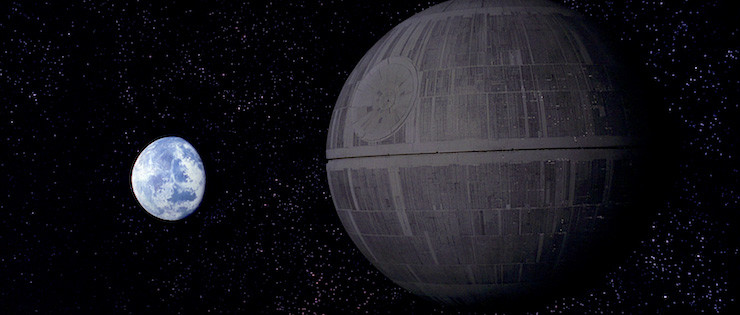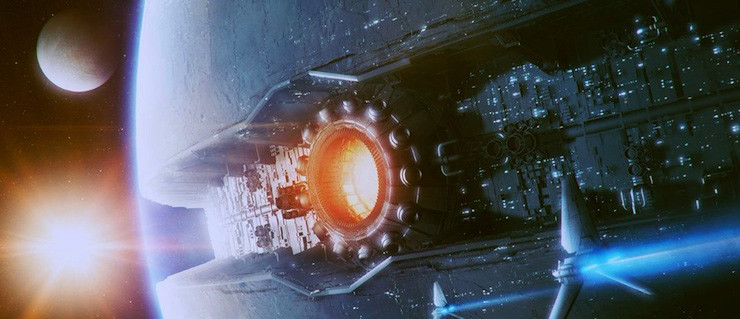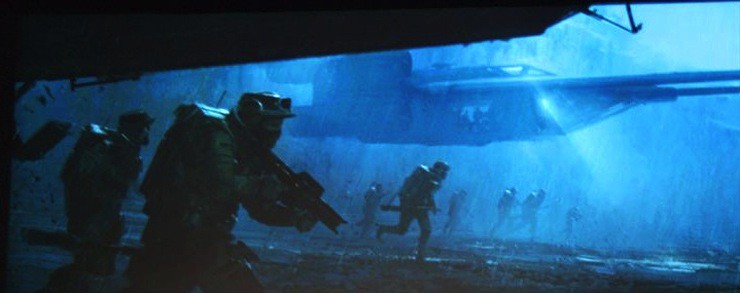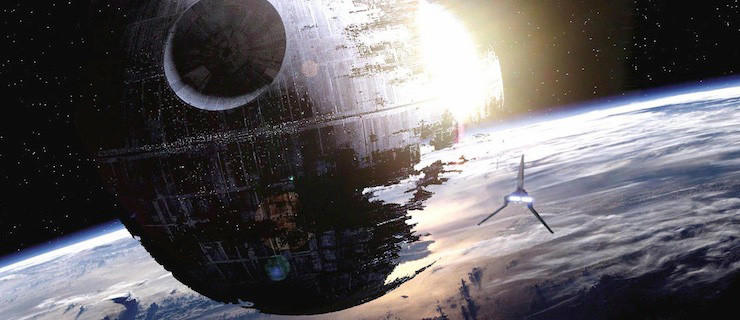With the release of the Rogue One trailer last week, we’re now officially into the “one Star Wars movie a year” release cycle. Early word is very promising too, and Gareth Edwards’ seems to have combined his ground level, character-centric approach with the Star Wars aesthetic to create something with a very different, yet familiar, flavour. Force 10 from Yavin IV, if you like.
But while the overall reaction has been positive, one of the minor criticisms I’ve seen raised is that this will be the fourth movie of an eight movie-and-counting series centred entirely around a Death Star. A New Hope is an entire script predicated on Chekov’s Battle Station, Return of the Jedi is much the same, and The Force Awakens got a lot of flak for its own version, Starkiller Base.
So, why go back there? Again?
In a word: history.
One of the things that the addition of the prequel trilogy did very successfully was provide context for the rise of the Empire. Those movies, along with the Clone Wars and Rebels cartoon series have done great work exploring the gradual ascent of Palpatine and the society’s subtle slide into dictatorship. There’s no switch that gets flicked, no sudden seizure of power beyond Order 66; Palpatine just slowly curdles popular opinion until he seems like the only choice. The first stage of his path to power ends with the slaughter of the Jedi. The second ends with the destruction of Alderaan.
This is the moment that the mailed fist of the Empire is revealed for all to see. Certainly in the lifetimes of the characters in A New Hope, a planet-killing weapon is unprecedented. Planets are occupied, wars fought, but the idea of simple, total obliteration of an entire world? That’s the moment the Emperor becomes a war criminal.

It’s also a perfectly timed show of force, with a small f. By revealing the Death Star’s existence the Emperor is also revealing his winning hand. He’s not taken control—he’s been GIVEN control, and the Death Star is his means of keeping it. He’s like the anti-Bond villain, revealing the truth after it’s far too late to do anything about it.
The first Death Star’s shadow falls on more than just Yavin IV. Its deployment sends a clear message to all the potential Rebels as well as the Alliance itself: we will find you. We will kill everyone around you to get to you. Surrender.
Just as importantly, it speaks to Palpatine’s arrogance. Not only does he want the largest weapon ever created, but he wants it to be used to literally and metaphorically reshape the galaxy. He is the final authority in what was the Republic, the arbiter of life and death. When viewed that way it could even be argued that this show of force is an act of revolt against the very thing that defines him. The Force may be everywhere, but Palpatine can remove big chunks of everywhere with one shot from the Death Star. Or at least he can, until it’s destroyed.
That’s why the second Death Star is so thematically powerful. Its very existence speaks to the Empire being on the back foot and temporarily outmaneuvered, returning to an old technique that almost worked as the Rebellion begins to gain momentum. Even the design of the station speaks to this, with its partially finished superstructure and the external shield generator protecting it. The Empire never learns why safety rails are a thing that happen, but give them credit: they made damn sure they closed that exhaust port.
If the first Death Star is the embodiment of Palpatine’s will, the second is the embodiment of his deviousness. The station’s fully operational central laser is a classic feint, the Empire on the ropes but far from powerless. The station also serves as the crucible for the multiple plots the movie, and Palpatine, have set in motion. It’s there that Luke is almost seduced to the Dark Side, and it’s there where the Emperor’s latest test of Vader’s loyalty fails, and there that the Empire finally begins to die. Again, it’s an immensely powerful image, both in-universe and as part of the movie: Palpatine dying in the half-completed remains of his ultimate weapon as the Dark Side’s greatest champion returns to the light. The Empire defeated by their own inability to adapt.
Its powerful stuff, which is one of the reasons people had a problem with Starkiller Base in The Force Awakens. On the surface, that’s a textbook piece of sequel bloat; the same idea but larger, more powerful and angrier. There’s certainly an element of that, and whether or not that’s a deliberate evocation of A New Hope or a lazy cover version is going to be debated for years. What’s really interesting, though, is what Starkiller Base says about The First Order and their relationship to the Empire.

My friend Andrew Reid goes into excellent detail on this, but it can be summed up as follows: the First Order are children wearing the Empire’s clothes. They’re desperate, uncertain, and savagely cruel. They want to re-establish and finish what the Empire started and they want to do that as quickly as possible. And what was the single, historical, epoch-changing event of the last few decades?
The destruction of Alderaan by the Death Star.
Yes, Starkiller Base is a riff on the Death Star but the point is that it HAS to be. The First Order are desperate for a foothold, to carve their name into the galaxy not as the endgame of their rise to power but as the first step. That’s why they don’t just rebuild the Death Star, but massively overpower and over-design it. Because Palpatine’s game of political chess has now been replaced by operatically excessive destruction and a hint of terrified brutality.
So, the three Death Stars we’ve seen on screen to date all have very good historical reasons for being there. One is a punctuation mark on history, another is a last gambit, and the third is a desperate attempt to evoke the old, dark glories of the villains’ predecessors. That brings us back to Rogue One.
There are three reasons we need to revisit that first Death Star. The most obvious is, again, historical context. The Death Star and its victims are the hub around which this entire era of the Star Wars universe turns. Its existence embodies everything about the Empire, and the resistance to it embodies everything about the Rebellion: implacable, absolute violence versus terrified, under-equipped bravery. This is rich ground and it makes perfect sense for the first ‘Story’ movie to mine it.
In turn, returning to that period also opens the door to the much talked about spotlight movies. In order to successfully produce films centred on Boba Fett, Han Solo, or any of the others it’s necessary to effectively reintroduce those characters to the post-Force Awakens audience. Yes, a huge portion of that audience will undoubtedly know them already. But some won’t, and by returning to this massively significant event, Rogue One helps set the table for every Story movie that will follow it.
Finally, there’s the possibility of Rogue One exploring the human cost on both sides of the conflict. Randall’s monologue in Clerks about the contractors who must have died on the Death Star, like all Randall’s best material, has some truth to it. If, as seems likely, Rogue One shows us the innocent victims and misguided soldiers forced to build the Death Star then it casts both the Empire and the Rebellion in a very different light. What do you do if you realize your actions will kill millions? What if, in saving those millions, you ensure tens of thousands will die? Where’s the line?

We don’t know for sure that sort of moral ambiguity is going to be part of the movie but the signs certainly point in that direction. If it’s done right then we’ll be looking at an examination of the biggest event in this fictional universe’s history from a realistic, complex perspective. If it’s handled badly, then it’ll be a horrible misstep at a crucial moment.
But from the small glimpses we’ve seen, that doesn’t look likely. Instead, Rogue One looks like it will expand the tone and scope of the Star Wars universe—not so much a New Hope as a New Perspective, and one that uses the worst thing the Empire ever did to tell a story about one of the Rebellion’s finest hours. It’s going to be a long wait to December 14th…
Alasdair Stuart is a freelancer writer, RPG writer and podcaster. He owns Escape Artists, who publish the short fiction podcasts Escape Pod, Pseudopod, Podcastle, Cast of Wonders, and the magazine Mothership Zeta. He blogs enthusiastically about pop culture, cooking and exercise at Alasdairstuart.com, and tweets @AlasdairStuart.











I have also wondered about the inclusion of Starkiller Base in TFA. On one hand, yeah, it’s kind of a lazy call back, but on the other, it’s almost a kind of meta statement about the First Order itself resorting to lazy callbacks or trying to reclaim the good old days or what have you. (I still think maybe the destruction should have been in the second movie for pacing reasons, but eh).
As for Rogue One, honestly, I guess I wasn’t thinking about it in such thematic terms, but it seems to me like a pretty interesting story to tell! A New Hope begins right in the middle of action, with Leia hiding those plans. So of course you are going to wonder where they came from!
In truth, I’m a lot more nervous about the Boba Fett/Han Solo movies. Sometimes it’s best to keep cool characters a little shrouded in mystery instead of trying to explain everything about them (heck – I like the prequels and a lot of people feel that way about Vader/Anakin, I think. At least with Vader it makes sense, because his arc is what drives all 6 movies). Plus sometimes there is such a thing as too much of a good thing; sometimes it’s the relationships with other characters that are part of what make them so cool and fun to watch. Overall, I prefer what Rogue One is doing – taking time to explore the side stories and characters you never hear about. But maybe they will surprise me.
A fair treatise on the subject!
I have few complaints about The Force Awakens, and I enjoyed it a lot, but now that they’ve done the Death Star a third time, I worry about what’s next. Will three Starkiller Bases be conjoined that can eradicate entire galaxies? Will the third movie involve destroying the Death Star factory? The scope creep feels a little out of hand. I hope Disney/Abrams/whoever has something unexpected in mind.
I have no patience for those who think TFA is a ANH rehash, and that complain about Starkiller Base. They missed all the subtext, and it’s not even that “sub”, to start with.
@1, I’m actually really looking forward to a good Boba Fett movie. I just hope they avoid the temptation to make him a good guy. He needs to be an amoral S.O.B. Plus they need to cast Manu Bennett, but that’s just me. :)
I actually like the theme—as embodied in Kylo Ren—of trying to emulate your [villainous] heroes. Of the First Order emulating the Empire. Even with them doing so with less maturity, as exhibited by Kylo Ren’s lightsaber tantrums and General Hux’s scream speech. I just chafe a bit that they’re way more successful at it than the ones who came before and in so short a time. The Emperor took a lifetime in growing the Empire to what it was. But the First Order rose quickly, and Kylo Ren is now complicit in far more genocide than Darth Vader ever was. He’s like a child who’s fire bombing whole countries in an attempt to copy his grandfather who only tossed a few grenades at some people in his day. At times it feels like the Rebellion, in throwing down the Emperor and destroying the second Death Star, made things worse for the galaxy by sewing the seeds of the First Order. It greatly downplays the victory at the end of Return of the Jedi.
All that said, the bigger mysteries lie in Snoke, and what becomes of Kylo Ren next. I maintain hope that this is all going somewhere we haven’t thought of.
I see the results of The Return of the Jedi as being similar to what we’ve done in the Middle East, except being done to the Republic/Empire by itself. The problem with getting rid of the Big Bad is that the Big Bad actually served a purpose. If you destroy the central government, what takes its place? At least for a while, nothing.
In the contemporary world, look at Libya and Iraq. Historically, look how long it took for western Europe to recover from the withdrawal of the Roman Empire.
After killing the Emperor, there was nothing that could just jump in and take over. He had spent his entire life dismantling all the mechanisms of the Republic. It takes time to rebuild all those mechanisms.
This gave the First Order a much clearer path. There were no mechanisms in place to subvert. It was a clear field.
Again, another historical analogy. After World War I, there was an attempt to recreate Germany as a democratic state. But it didn’t have all the mechanisms in place, so when it hit its first rough time the democracy failed, and a strong man was in a great position to sweep to power.
Well, from what we’ve seen, I don’t know if the First Order has really managed to recreate much of the Empire as a whole; they built a massive weapon, and obviously have troops and a navy, but I got the feeling they didn’t actually control a significant part of the galaxy; they were just being a nuisance out on the Outer Rim until they demonstrated their capacity to do something awful.
(For a less politically-charged parallel, maybe the events of Nemesis Games, the most recent Expanse novel?)
the First Order are children wearing the Empire’s clothes.
YES!!! Everything about what the FO did was about inadequacy and showboating.
I can’t decide whether the First Order being raging fanboys playing dress-up is lazy rehashing or brilliant satire. Hmm…I’m going to try to be positive and go with the latter. It does give your villains a new shade of interest when they’re as media savvy (and pathetic) as they are scary. Is this Star Wars for the Trump era? Star Trolls?
The Death Star in episode IV was scary and impressive. It actually destroys the home planet of someone we’re growing deeply attached to and has some real gravitas.
The Death Star in ROTJ felt like weak sauce because it wasn’t actually used until the end. I would argue that, in context of all six movies up to that point, Luke is the real “Death Star” of Episode Six. The fact that we end the movie finding out he isn’t a weapon for the Empire, but for the Resistance is the true victory, the true turning point in the whole story. It’s a good point to end on because we know that, with Luke, the war is going in to mop-up mode.
Or is it? Luke goes off the rails, the reformation isn’t as smooth as expected, and “balance in the Force” still doesn’t mean “good wins”. Skywalker blood is still seeping deeply into the fabric of the galaxy, and the First Order has plans.
That being said, their main weapon is their major base? That’s a bad case of:
1. putting all their eggs in one basket and
2. living in their car.
Kinda hard to take them serious, even if their field generals weren’t Captain Emo and Captain Compactor.